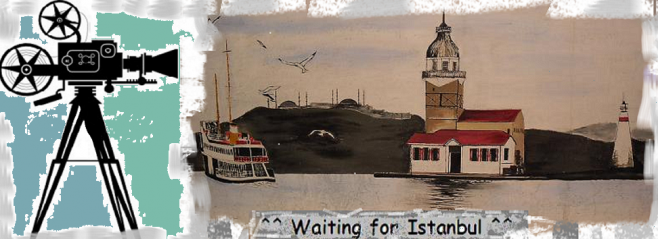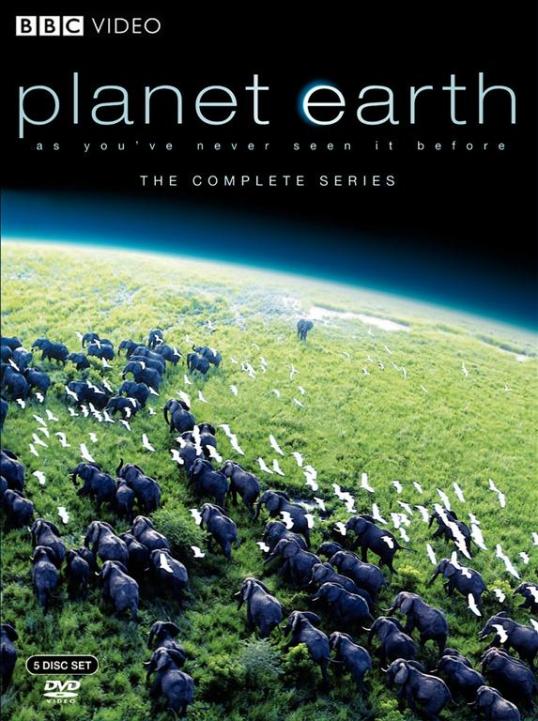Reviewed by Ann Kelly
Updated 11 November 2007
For fans of wildlife programmes, Earth will be nothing new – it is, after all, a re-cut version of the BBC series Planet Earth – but this is a wildlife film at the very top of its game. No shot is less than dazzling, most are beautiful and many are stunning. Astounding images of whales cavorting in the oceans, rivers crashing down mountain-height waterfalls, cherry trees blossoming in time-lapse and many other wonders are complimented admirably by the rich, authoritative tones of narrator Patrick Stewart.
Earth concentrates on a few animal characters in order to take us on a rough journey from the North to the South pole over a year. There’s a polar bear family, with cute fluffy cubs sliding in the snow. A herd of Kalahari elephants trudge through a drought and lions to reach water, and a humpback whale and her calf journey halfway across the world. This focus helps add drama and, while the voiceover does occasionally veer into the pompous, it manages to steer clear of anthropomorphism. Plenty of other creatures get a cameo moment in the spotlight too – one bizarre bird-of-paradise dance makes a particularly memorable sequence.
“IMAGES OF THIS BRILLIANCE ARE NATURALLY UPLIFTING”
Depsite various deaths amongst the animals featured, Earth is a surprisingly bloodless experience, presumably to ensure family-friendliness. The camera always cuts away before the final bite, and there’s not so much as a meaty bone to be seen. But despite this censorship of the nastier things in nature, there’s a serious message overlaying the pretty pictures. The damage mankind is doing to the earth is made starkly clear. Still, gloomy message notwithstanding, images of this brilliance are naturally uplifting – and if this doesn’t make it to IMAX, I’ll eat my sustainable eco-hat.
http://www.bbc.co.uk/films/2007/11/12/earth_2007_review.shtml
From a National Catholic Register review
By Steven D. Greydanus
A 20-foot great white shark hangs in the air, its entire bulk suspended a meter or more above the surface, its jaws closing on a fur seal gulped from the surf in a mighty leap.
Time-lapse photography reveals exotic fungi extruding netlike, lacy veils, bright orange slime molds throbbing and quivering as they spread across the rain forest floor, and bare winter forests budding and flowering in waves of vibrant color as if catching fire.
In New Guinea, a male Superb Bird of Paradise pogos energetically up and down in circles around a diffident female, its head swallowed in a wide erectile cape — a bizarre, hopefully impressive oblong fan of black plumage with a slash of blue across the bottom, like a gaping mouth below its shining eyes.
A menagerie of African animals, struggling through the parched Kalahari to the Okavango river for the seasonal floods, luxuriate in the extraordinary abundance of water. Giraffe and zebra placidly wade, baboons clumsily wobble waist-deep on two feet, and exhausted, dehydrated elephants joyously cavort and even swim.
Welcome to Earth. Adapted by directors Alastair Fothergill and Mark Linfield from producer Fothergill’s groundbreaking 550-minute BBC miniseries “Planet Earth,” Earth offers an impressive selection of some of the most astounding images ever captured of the natural world. Many of the film’s sights had never been witnessed or photographed before Fothergill and the BBC Natural History Unit set out to create “the definitive look at the diversity of our planet,” as “Planet Earth” is not unreasonably billed.
Filmed in stunning high-definition digital video, the luminous imagery looks even better on the big screen — reason enough for “Planet Earth” lovers who’ve seen it all before on DVD to experience Earth in theaters. (That includes our family; “Planet Earth” is a favorite in our house.) For the uninitiated, Earth offers a terrific 90-minute tour of the nine-hour “Planet Earth” experience — one that will satisfy many viewers while sending others in pursuit of the complete package on DVD.
In distilling his acclaimed series to feature length, Fothergill repeats the approach he took with the predecessor to “Planet Earth”: the 400-minute miniseries “Blue Planet,” which likewise became the basis for a 83-minute feature film, the 2003 release Deep Blue. One might think, then, that just as “Planet Earth” exceeded even the impressive achievement of “Blue Planet,”Earth naturally ought to outdo Deep Blue.
But Deep Blue, as top-notch as it is, made less than $20 million worldwide, and wasn’t even an asterisk on domestic box office charts in limited release. With Earth, the filmmakers are determined to reach a wider audience — and they’ve made compromises to do it.
In true BBC tradition, both “Blue Planet” and “Planet Earth” are extensively narrated in the warmly professorial cadences of Sir David Attenborough, who provides a wealth of context to the images on the screen. (For some reason “Planet Earth” was redubbed for U.S. broadcast with Sigourney Weaver, though the DVDs feature the original Attenborough narration.)
Deep Blue’s approach is very different, but equally effective: In the tradition of wordless or nearly wordless nature documentaries like Atlantis, Microcosmos and Winged Migration, Deep Blue largely eschews narrative altogether, allowing the imagery to speak for itself. Like these other films, Deep Blue is more a nature art film than a traditional educational documentary. (What narration Deep Blue does have was originally done by Michael Gambon; the U.S. DVD features Pierce Brosnan.)
With Earth, on the other hand, the filmmakers went a route closer to a much less distinguished 2007 documentary-esque nature film, Arctic Tale. Many critics noted Arctic Tale’s similarity to Disney wildlife adventures of the 1950s, and Earth, the premiere film from Disneynature, the Disney empire’s new big-screen nature documentary label, is consciously in that same tradition.
In aiming squarely at family audiences, both Earth and Arctic Tale have their eye on the March of the Penguins dollars, hoping for the same success with family audiences that powered the Morgan Freeman–narrated documentary to hit status in 2005. Arctic Tale’s breezy, laid-back narration by Queen Latifah, and Earth’s sometimes humorous narration by James Earl Jones, seem intended to imitate the appeal of Freeman’s work in March of the Penguins. (Prior to its U.S. release, Earth was originally narrated by Patrick Stewart. For that matter, Freeman’sMarch of the Penguins narration was also added for that film’s U.S. release.)
Arctic Tale purported to tell a pair of stories about a polar bear family and a walrus family. Earth is likewise structured around three family stories: a tale of a polar bear family with striking similarities to that of Arctic Tale; the trek of a herd of elephants through the Kalahari, and the migration of a mother humpback whale and her calf.
Earth begins on a sonorous note similar to the miniseries, but popular accessibility is clearly a top priority. One can hardly imagine Attenborough tossing in lines like “Get down, baby,” for instance. There are even a couple of Mouse House allusions: a comment about the “circle of life” (a phrase with even more Disney resonance when read by Jones, the voice of The Lion King’s Mufasa) and a punchline about Mandarin duck chicks “falling with style” from their hollow-tree nests to the forest floor below. (Actually, there’s not much style to it.)
Despite similarities, Earth is far superior to Arctic Tale, and presents the animals’ stories much more authentically. Where Arctic Tale fabricated entirely fictional narratives by dovetailing unrelated footage — even creating named fictional characters (“Nanu,” “Seelah”) embodied by different animals in different shots — Earth doesn’t fictionalize, or not much.
The filmmakers really follow the migrations of one elephant herd and one whale mother and calf, and as far as I know they follow the same four polar bears throughout (a mother with two cubs and a male — though whether the male is really the cubs’ “dad” is anyone’s guess; their stories don’t overlap).
While a definite vibe of climate-change awareness-raising runs through the film — more so than the miniseries — it’s nothing like the public-service infomercial that Arctic Tale finally becomes.
Like Arctic Tale, Earth isn’t particularly “red and tooth and claw” for a nature documentary — but also doesn’t shy away from the harsher realities of life in the wild. Among Earth’s most riveting sequences are a high-speed chase in which an arctic wolf runs down a fleet-footed caribou calf and a nocturnal sequence with a famished pride of lions desperately takes on a panicked elephant — and there are those breaching sharks scarfing fur seals whole — though there’s never a killing stroke or a bloody feast afterwards. (The miniseries isn’t so squeamish.)
Earth emphasizes the cosmological distinctiveness of our planet: just the right distance from our sun, with a crucial 23.5-degree tilt that creates seasonal change and contributes to the planet’s hospitableness to such a staggering diversity of species in so many different environments. In a sea of Hollywood formula, artifice and escapism, here is an invitation to wonder, awe and gratitude.


